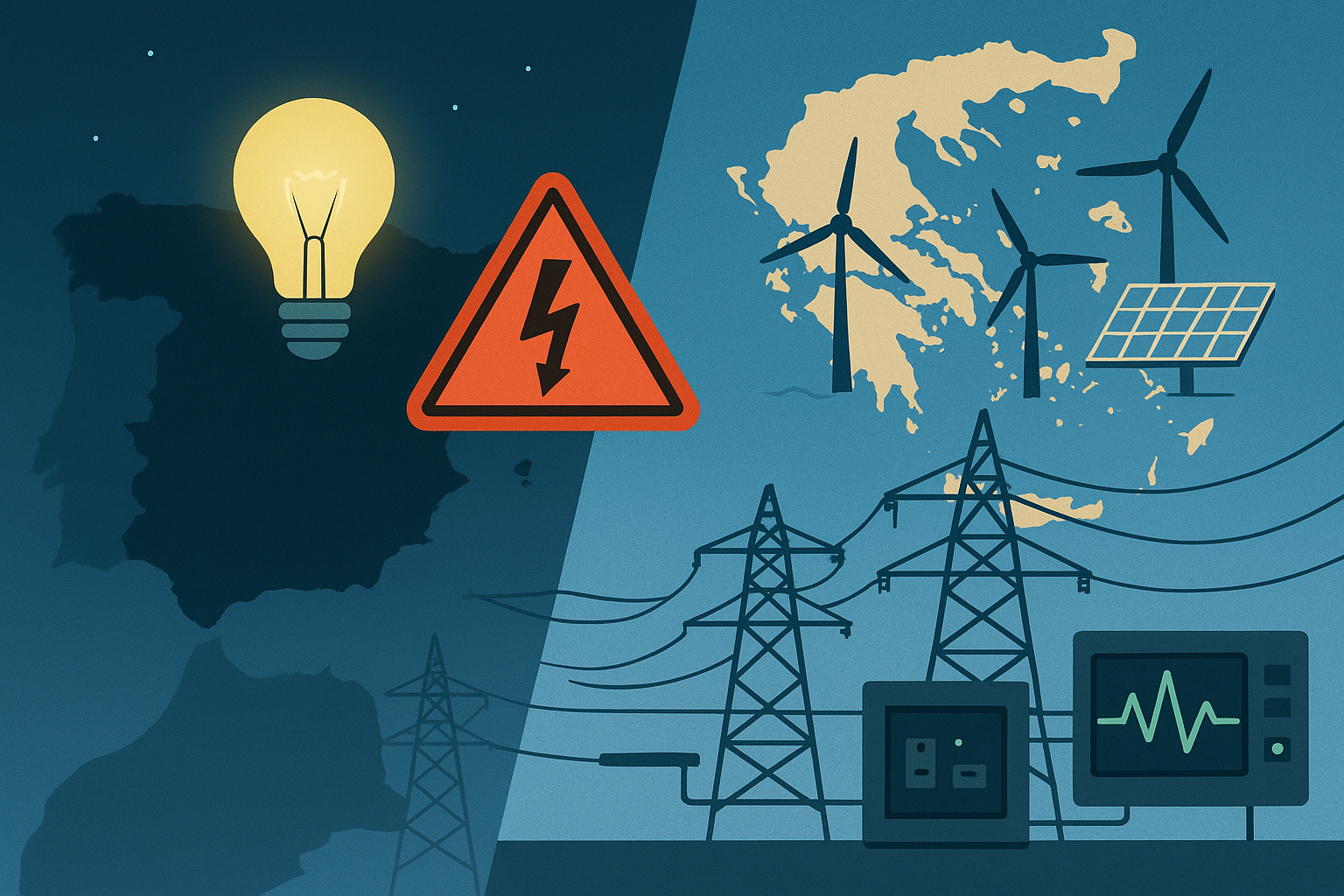
Newsroom / Center News
When the Lights Go Out: Lessons from the Iberian Peninsula Blackout

The Wrong Blame
The ENTSO-E Expert Panel Report delivers a clear verdict: renewables were not the cause. Indeed, renewable energy sources were operating within their expected parameters. The real culprits were systemic vulnerabilities in grid management, not the technologies generating electricity. Before the blackout, the Iberian system showed low inertia (120 GW of kinetic energy stored in rotating machines) and subtle voltage oscillations: both early warning signs of instability that went unnoticed. Solar and wind output was high that morning, with exports to France reaching 5 GW, stressing internal voltage control mechanisms. Yet, operational planning found no violations, and the Regional Coordination Centres declared the system secure.
At 12:32:00, the first disturbances appeared: a net load increase of 317 MW as small rooftop PV systems disconnected, followed by another 208 MW of distributed generation tripping. Within 90 seconds, a transformer in Granada failed, and cascading overvoltages caused over 2 GW of renewables—mostly solar—to disconnect. By 12:33:19, the Iberian grid had lost synchronism with Continental Europe; seconds later, it collapsed entirely.

What Really Happened: A Grid, Not a Generation Problem
Technically, this was a voltage-driven event, not a supply deficit. In fact, overvoltage tripping caused the chain reaction and not the lack of renewable reliability. The system’s vulnerability was rooted in insufficient reactive power management and poor damping of oscillations across the transmission and distribution layers. As the report emphasizes, voltage problems must be managed locally, something that today’s network design is ill-equipped to do, especially with growing volumes of distributed generation.
What the blackout exposed is a mismatch between how Europe produces electricity and how it moves it. The Iberian grid, like many others in Europe, was built for centralized fossil-based generation feeding a unidirectional flow. Now, electricity is generated everywhere—from rooftop PVs to offshore wind farms—and the grid must adapt to multidirectional, volatile flows that challenge stability and inertia.
The Real Need for Grid Investments and Developments
This blackout should not slow down the clean-energy transition. On the contrary, it underscores the urgency to modernize the grid. Investments are needed in three key areas:
- Voltage and Frequency Control Infrastructure: Advanced reactive power compensators, dynamic voltage regulators, and synthetic inertia from battery and inverter systems must be deployed at scale.
- Digital Monitoring and Local Automation: Substation-level voltage management and real-time data exchange between TSOs and DSOs are vital to detect oscillations like the 0.63 Hz and 0.21 Hz waves that preceded the blackout.
- Grid Reinforcement and Interconnection: Spain and Portugal’s isolation—limited to 3–4% of interconnection capacity with France—magnified the problem. Greater cross-border transmission is Europe’s most reliable safety net.
Beyond the Blackout: Lessons for Greece
The Iberian blackout of 2025 was not a failure of renewable energy — it was a failure of infrastructure adaptation. And that lesson resonates far beyond Spain and Portugal.
Greece’s transmission system, like that of the Iberian Peninsula, sits at the geographical edge of Europe’s interconnected grid. It faces similar challenges: growing shares of variable renewables, limited cross-border interconnections, and increasing voltage control demands on the 400 kV backbone.
Greece has already installed more than 13 GW of renewable capacity, with demand ranging between 6–6,5 GW during low-load periods and peaking around 11 GW in the summer. The system has come dangerously close to failure twice in recent years — in August 2023 and February 2024, when nearly 1 GW suddenly vanished from the grid.


With more than 70,000 distributed generation units now connected, grid supervision and stability control have become exponentially more complex. Instead of a few dozen large, high-capacity plants as we had in the past, we are moving toward a system made up of many small generation units— a level of fragmentation that makes grid control and system supervision far more complex.
Today, midday often brings an excess of electricity — leading to curtailments, meaning energy is literally thrown away. But even that is not simple; it requires advanced technology and operational readiness to detect the surplus in real time and issue disconnection commands. The development of energy storage systems can play a double role: preventing renewable overproduction from being wasted and enhancing grid security and stability.
Modern energy networks are now characterized by wide decentralization and deep renewable penetration. This creates new challenges that require upgraded management systems — to avoid both shortages and overproduction, either of which can trigger a blackout. In electricity, timing is everything: operations must respond within fractions of a second.
Europe must invest €67 billion annually through 2030 to strengthen its electricity grids — a target that Greece must align with. For Greece, that means:
- Expanding interconnections with neighboring systems
- Maintaining fast-response natural gas units as thermal backup to stabilize frequency and voltage.
- Accelerating energy storage projects — large-scale batteries and pumped hydro — to absorb surplus RES generation and release it when needed.
- Upgrading existing infrastructure (substations, cables, transformers etc.)
- Deploying smart grid automation at substation level to detect and correct local oscillations in real time.
The Iberian blackout illustrates the stakes. As renewable penetration deepens — and as Europe electrifies transport, heating, and industry — the balance between inertia, reactive power, and digital coordination will define who keeps the lights on.
For Greece, this is not merely a technical challenge. It is a test of foresight — whether policy, regulation, and investment can converge fast enough to ensure that the country’s clean-energy transition remains both green and reliable.



